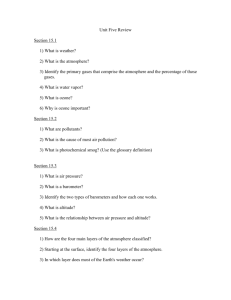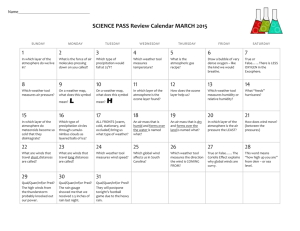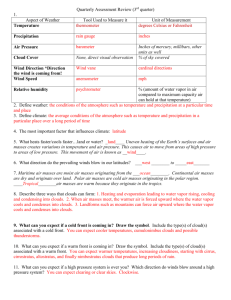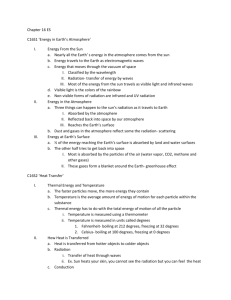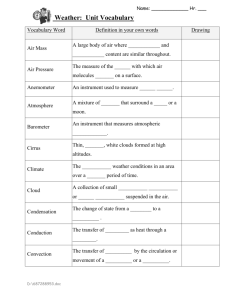Chapter 16 Study Guide
advertisement
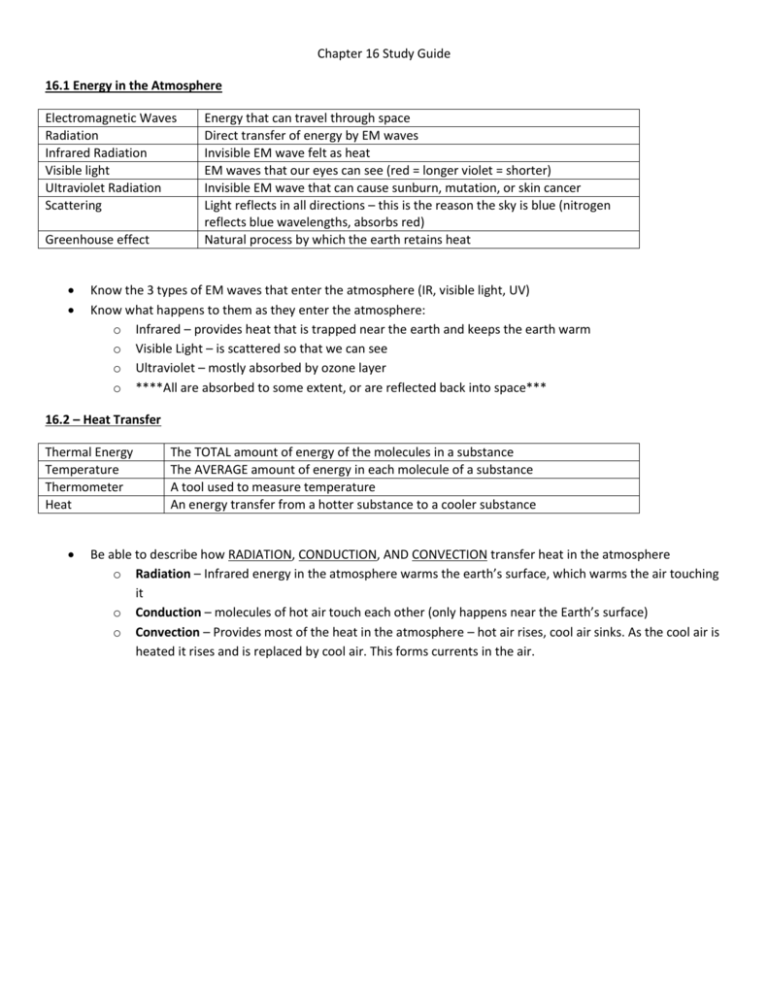
Chapter 16 Study Guide 16.1 Energy in the Atmosphere Electromagnetic Waves Radiation Infrared Radiation Visible light UItraviolet Radiation Scattering Greenhouse effect Energy that can travel through space Direct transfer of energy by EM waves Invisible EM wave felt as heat EM waves that our eyes can see (red = longer violet = shorter) Invisible EM wave that can cause sunburn, mutation, or skin cancer Light reflects in all directions – this is the reason the sky is blue (nitrogen reflects blue wavelengths, absorbs red) Natural process by which the earth retains heat Know the 3 types of EM waves that enter the atmosphere (IR, visible light, UV) Know what happens to them as they enter the atmosphere: o Infrared – provides heat that is trapped near the earth and keeps the earth warm o Visible Light – is scattered so that we can see o Ultraviolet – mostly absorbed by ozone layer o ****All are absorbed to some extent, or are reflected back into space*** 16.2 – Heat Transfer Thermal Energy Temperature Thermometer Heat The TOTAL amount of energy of the molecules in a substance The AVERAGE amount of energy in each molecule of a substance A tool used to measure temperature An energy transfer from a hotter substance to a cooler substance Be able to describe how RADIATION, CONDUCTION, AND CONVECTION transfer heat in the atmosphere o Radiation – Infrared energy in the atmosphere warms the earth’s surface, which warms the air touching it o Conduction – molecules of hot air touch each other (only happens near the Earth’s surface) o Convection – Provides most of the heat in the atmosphere – hot air rises, cool air sinks. As the cool air is heated it rises and is replaced by cool air. This forms currents in the air. 16.3 – Winds Wind Anemometer Wind-chill factor Local wind Sea breeze Land Breeze Monsoon Global winds Coriolis Effect Jet stream Horizontal movement of air from HIGH to LOW pressure areas Tool used to measure wind speed – records in rpms then converted to MPH How cold the air temperature will feel outside due to the wind Winds that are the result of uneven heating over a small area, usually where water (lakes and oceans) meet land. A local wind that blows from the water towards land during the daytime because the air over the water is high pressure A local wind that blows from the land towards the water at night because the air over the land is higher pressure Land and sea breezes over a very large area of Asia, responsible for dry and rainy seasons Winds that blow from very specific, unchanging areas over a large distance The effect of the earth’s rotation on the way winds curve High speed, high elevation winds that blow west to east that curve N and S. Wind always moves from an area of HIGH pressure to an area of LOW pressure Wind is always caused by pressure differences in the air – which is caused by heating of the earth by the sun. Winds are named for the direction they blow FROM o i.e. a wind from Canada towards the US would be a north wind Anemometer – a tool used to measure wind speed. Wind chill factor – the increased coolness felt by a wind. o Only applies to living things!!!!! (can’t freeze water) Show on a map winds blowing from high to low areas Correctly name local winds (north, south, southwest, etc.) Be able to label diagrams of sea and land breezes o Which areas are high (H) and low pressure (L) o Draw in arrows showing wind direction and temp (warm or cool) Connect global winds to convection currents Correctly draw curved arrows on a globe to show the coriolis effect o Use this concept to understand Prevailing Westerlies and Polar Easterlies o Westerlies – blow towards the poles from equator, earth’s rotation causes Them to blow from west to east – affect US weather!!! Easterlies – blow towards equator, rotation causes them east to west. These collide with the westerlies, causing major weather changes in the US Jet Stream – know what they are and approximately where they are on a map – how do we use them (conserve fuel in west to east flight). 16.4 – Water in the Atmosphere Evaporation (pg.545) The process of liquid water becoming a gas (water vapor) due to heat. Humidity (pg. 546) Relative Humidity (pg. 546) The amount of water vapor in the air The RATIO of water vapor in the air to the total amount the air can hold. Expressed as a percent (%) A tool used to measure relative humidity The process of water vapor cooling to a point that it bonds with other particles and forms liquid water The temperature at which water vapor in the air will condense. This causes a frost if the dew point is below 32o F Big, puffy clouds that indicate no rain. Low to the ground (< 2km). Cumulonimbus clouds can be very tall (2 miles!) and indicate thunderstorms Long wavy, rolling clouds that indicate rain is coming. Nimbostratus produce rain, drizzle, or snow Clouds that form very high in the atmosphere. Look like wispy horse tails or strings of cotton balls. Formed by small ice crystals due to cold temperatures in upper troposphere Psychrometer (pg. 546) Condensation (pg.547) Dew Point (pg. 547) Cumulus (pg.548) Stratus (pg. 548) Cirrus (pg.548) Know that as the relative humidity increases, the lilkelihood of rain increases. Air must be at 100% humidity for rain to form - but it can fall in areas of less than 100% humidity Understand what relative humidity means and that air of different temperatures will have different relative humidity (hot air holds more water vapor because it is less dense than cold air) Understand how clouds form Identify different cloud types: cumulus, stratus, and cirrus o “nimbus” – rainclouds – nimbostratus and cumulonimbus 16.5 – Precipitation Know the 5 types of precipitation and how they form: Rain: Rain is at least 1/2mm and falls quickly Drizzle/Mist is less than ½ mm and falls slowly Both require warm air (above freezing) and a warm surface (above freezing)to remain rain Freezing Rain: Sleet: Hail: Snow: Requires cold air (below freezing) Forms ice crystals in clouds Will accumulate only if ground is also below freezing **Only HAIL and SNOW are solid states of water when they fall from the clouds – all other forms of precipitation start as liquid water**
